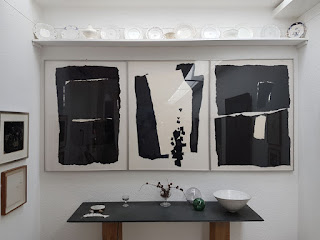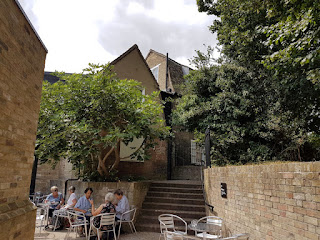We then all walked to Kettles Yard, an art gallery and museum not far from Jesus Green. After a re-development costing over £11 million it was reopened this spring and at present it is hosting a special exhibition by Antony Gormley - free as well!
There were just five items and so each had a lot of space from which to view it. The first was similar to the Crosby Beach sculptures near Liverpool which we saw in 2013. Almost tucked into a corner this item was used in the publicity posters for the exhibition and, before we visited, it had seemed as if the image was unreal. even though it really does seem to hover a few hundred mm above the ground with feet just touching the wall, staff told us that it took some considerable building work, including using very heavy metal beams on the other side of the wall, to achieve this effect.
The next item was much harder to photograph - it is made as two wire frame body shapes, one inside the other. The inner one looks as if it is diving into water.
This figure shows Gormley's current interest in making shapes with cubes or lines. In the same space was a further item. two 6mm square steel wires, one vertical and the other horizontal and stretching out through the entrance into the next room. They were slightly separated by about 300 mm. With very few visual cues, they were quite disorientating - sometimes they seemed to intersect, at other times created the feeling of looking at a mirror.
Finally, a thousand LED in a regular cube surrounded by reflective glass mirrors - it was the only form of lighting in this room.
Although the viewer could see into the cube, light was then reflected from all other sides creating an infinite view. Even more weird was the very dim reflection of one's own face just visible 'behind' all the other lights. Unusually all that could be seen was a pair of eyes looking back.
We then watched most of a BBC documentary program about the work of Antony Gormley until it was time to assemble downstairs for our visit to the House (we were given timed tickets for 12:20 when we first arrived). Originally a row of cottages but knocked through to make a single dwelling, it was the home of Jim Ede and his wife. Jim had been a curator at the Tate Gallery in London and came to know many of the leading, especially avant garde, artists of his time. Before they became famous he was able to collect many different pieces in quite distinct styles. He was also famed for collecting chairs.
During the war they lived in Morocco, building their own house there but returned to live in Cambridge in 1956. Jim and Helen created Kettles Yard where it was almost 'open house' for anyone to come and view his collection. When they moved to Edinburgh in 1973, they left the house as they wanted it to be left forever. Helen died in 1977 but Jim survived until 1999. Jim had already gifted Kettles Yard to the University of Cambridge.
Initially, the visit took us to the original cottages - she had a bedroom and bathroom downstairs and he had the same upstairs. The massive collection was everywhere and chairs - visitors are allowed to sit in them even if they cannot touch anything else! - filled any otherwise unused space. It did not seem as if there was anywhere left for ordinary living.
After looking through the old house the tour continues through the new gallery which is very light and airy but almost equally full of Ede's collections.
This gallery especially shows the heterogeneous nature of Ede's interests - particularly the way in which very different objects are placed together in displays.
Outside, it is interesting to see how the old and the very new are blended together in the various parts of the very compact site.
Back then to the boat for lunch - we had originally thought about various other things to do in the afternoon but we were all too whacked by the heat!#
We had already booked tickets for tonight - a performance of The Merchant of Venice as part of the Cambridge Shakespeare Festival. Four plays are presented for about four weeks and then another four for the second half of the season. They all take place open air in the grounds of various colleges.
Our event took place at Downing College and we took with us, as recommended, our picnic meal. We planned our arrival for 6:30 as soon as the gates opened - although we were not the first.
The recommendation was to take our blanket to the front - we sneakily manage to occupy three seats as well as two of us sitting on the grass to eat.
Gradually others turned up and more picnics were set out even in front of ours. Mere filled rolls were quite pedestrian compared with some of the assortment that was brought out of substantial bags.
Eventually it was time for the performance to begin. A cast of ten was amazing and the production made very effective use of the space, including various trees and shrubs.
Of course, photography during the performance was not allowed so you will just have to use your imagination - just as we did when asked to believe that the setting was either Venice or Belmont, the home of the rich Portia whom Bassanio is chasing for marriage.
The cast brought the humour, sometimes in sections that are not always thought to be so funny - but after all, it is supposed to be a comedy.
During the interval, mulled wine was available - very tasty! By now the sun was setting and floodlights were switched on to supplement the last of the sunshine.
The court room scene not only brought out deep emotions but also much of the inherent comedy. Little was done to make the appearance of Portia and Nerissa as lawyers (ie men) even remotely credible. This highlighted the way in which Portia both plays with the men in the court case - eventually saving Antonio from having to hand over his pound of flesh - as well as testing them over the ring which she gave Bassanio and he promise never to part with.
Finally, all is resolved, the various partners either marry or are reconciled and everyone - almost - lives happily into the future. Of course, in today's society the treatment of Shylock - having to renounce his religion and hand over his fortune - raises considerable tensions and the production made no attempt to gloss over this.
We were all impressed and entertained by the performance as we made our way back to the boat through a still-busy city centre.




















No comments:
Post a Comment